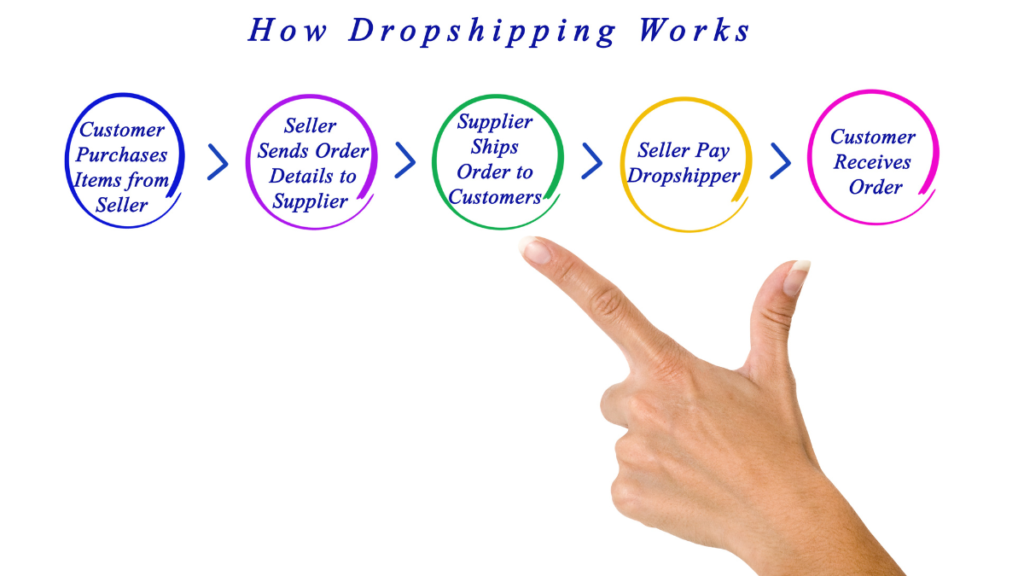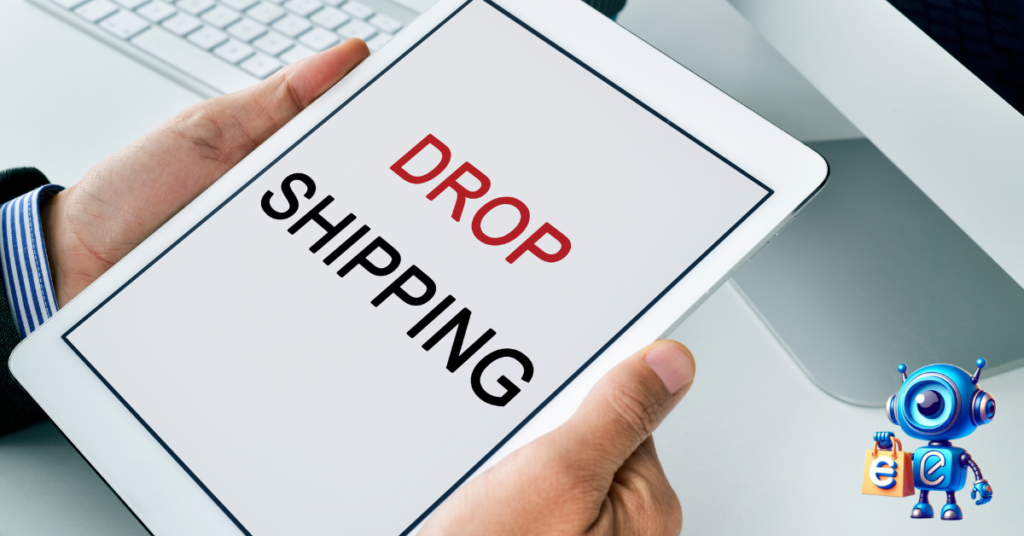With the low start-up capital required to start a dropshipping business, it is clear why this sector is booming these days. In 2024, the global dropshipping market is expected to reach more than $300 billion, a 23.7% increase from 2023.
These figures are projected to keep rising, and by 2026, the market size is expected to hit $476.1 billion.
Dropshipping, a business model with a promising future, offers numerous advantages, such as low start-up capital, streamlined supply chain management, and the potential for significant scalability.
These factors and the projected growth of the global dropshipping market make it an attractive venture for aspiring entrepreneurs.
However, this type of venture has its risks, and if handled in advance, your business can succeed in the first month.
But don’t panic. Every challenge has a solution. Here are some significant dropshipping risks and how to avoid them.
Table of Contents
What is Dropshipping?
Dropshipping is an ecommerce business model that allows entrepreneurs to start and run an online business without stocking inventory. The business owner agrees with manufacturers and suppliers to ship products to customers on their behalf.
When a seller receives an order, the wholesaler or supplier ships the products directly to the consumer.

As a store owner, this business is low-risk since you don’t have to stock or ship anything or worry about clearing your stock.
If you handle your business well, dropshipping can be a profitable investment. However, avoiding tough competition in this sector requires extensive involvement, such as marketing and creativity.
What are the dropshipping risks, and how can you avoid them?
Dropshipping is a lucrative business idea that anyone passionate about e-commerce can start. However, like any other business, this venture has many risks, making it hard for people to run a thriving dropshipping business.
Before venturing into dropshipping, you need to understand the dropshipping risks and compare them with the benefits you will gain.
But, importantly, you need to master how to avoid these risks.
Here are some of the most common risks in dropshipping businesses and tips on how to avoid them.
Low-Profit Margins
One risk that most drop shippers face is low-profit margins. The average profit margin for drop shippers is 20%, which needs to be higher after doing most of the selling work.
With drop shipping, you are not the actual seller; you are reselling other people’s products and earning a discount. The products are already made, so the manufacturer and dropshipping supplier have set their profit margins.
Additionally, the dropshipping sector already experiences high competition. Thus, you must ensure competitive prices when adding a new product to your store.
This is one of the significant reasons for low-profit margins.
However, there are specific ways that you use to avoid low-profit margins;
- First, you can increase your prices. Having the lowest product prices is not always good for your business. It would help to improve your prices until you reach your preferred profit margin.
- Another way to avoid this risk is to negotiate with your supplier for better deals. If they agree, you can get a significant discount.
- Lastly, you can focus on products with minimum advertised products (MAP), set mainly by suppliers, to deal primarily with competing merchants. Focusing on these products will avoid reduced commissions due to price wars.
Lack of Control
Lack of control is one of the most significant risks in dropshipping. Doing an ecommerce business is easier since you have total control over the company compared to drop shipping.
For example, when a customer complains about product quality or delays in shipping time, you can address the issues yourself as you control the business.
However, your supplier will determine everything when operating a dropshipping business. However, you will have the power to interact with your customers. Thus, you don’t have any control over the fulfillment and supply chain.
You will be forced to contact your suppliers and request that they address your issue. At the same time, you must keep your customers informed and assure them about something that is out of your control.
To avoid this risk, you need to;
- Partner with trustworthy suppliers. Since you don’t have access to the products, you must ensure your customers get the exact product you showed them. Thus, it would help if you had trustworthy suppliers to offer that.
- Communicate with your suppliers. Ask them as many questions as possible about the quality of the product, packaging, shipping time, materials used, and shipping methods.
- Invest in a chatbot like Ecommercebot to make communication with your customers easy.
Competition
Competition is a common challenge every drop shipper faces. It is not only in the dropshipping sector but also in e-commerce. Because everyone thinks that dropshipping is a get-rich-easy scheme, before investing in a dropshipping business, you must do thorough research.
However, investing in the dropshipping sector with a mentality that the competition is intense will make it easy for your competitors.
Getting your business off the ground will be more challenging.
But how can you avoid the stiff competition in dropshipping?
- It would help if you were unique with your dropshipping store. Most people are selling the same products and information from their suppliers. Having the same product isn’t the issue, but you can be creative with images, descriptions, and hashtags.
- Add reviews to your dropshipping store. Consumers are more likely to trust a brand with reviews than without reviews.
- Invest in marketing and advertising. You must be unique and tell the world about your store to attract more customers. Customers want to know what your store can offer that your competitor can’t. To make marketing and advertising easy, integrate your store with Ecommercebot and let the bot automate the tasks with its social media management feature.
Scammers
When running a dropshipping business, there is a high chance of becoming a scam victim. This occurs mainly if your supplier is unreliable because suppliers deal directly with the customers, working closely as partners. Therefore, the success of your business will depend on the quality of the products, their delivery, and their shipping speed.
One major scam in the dropshipping sector is selling unlicensed products. You can unknowingly sell counterfeit products, which can land you in legal problems. Also, some scammers may act as wholesalers, making you pay for products without shipping them.
Additionally, some wholesalers might have hidden fees. After placing your order, you might encounter some added fees when purchasing from them.
Furthermore, drop shippers are charged large amounts of money.
To avoid scammers in dropshipping, here are a few tips you can use;
- Before purchasing bulk orders, buy a few samples to inspect the quality of the products and check the brand’s reliability.
- Look for red flags such as slow customer support, subscription fees, bulk order demand, or anything suspicious.
- Discuss any additional fees before signing any agreement. If something seems fishy, wait to sign the deal.
- Request business registration documents, references, and Tax IDs from wholesalers. Cross-check the information to ensure everything is correct.
Choosing the Wrong Niche
Most dropshipping businesses fail during the first few months due to investing in the wrong niche. Some people want to sell everything; they think the more they sell, the more sales they make.
Choosing a broad niche can cause you to lose focus, which is difficult for small businesses. Focusing on a broad niche might take a lot of work to compete with the big guys in the industry.
Also, narrowing down might affect your business, especially in terms of naming and branding.

Focusing on an outdated niche can be risky for your dropshipping business. Some products are popular and in high demand during certain times, but the market goes down quickly after some time. Choose a niche that you are passionate about.
Choosing the wrong niche will affect your marketing, target audience, and content strategy. Here are some pointers to help you in selecting the perfect niche for your dropshipping business;
- Select a profitable niche that you are passionate about.
- Research the Amazon and AliExpress niches.
- Research on the most successful dropshipping stores.
- Look for an evergreen niche.
Stock shortages
Sudden stock shortages are one major issue dropshipping store owners face with their suppliers. For example, a customer may want to purchase a particular product, but it suddenly becomes out of stock.
This will create a weird situation where you must go “out of stock” for the item from nowhere.
Your customer will only be happy in such a situation, resulting in a good customer experience.
However, don’t stress yourself. As a dropshipping business owner, there are some ways to avoid this;
- It is good to work with over one supplier. Working with multiple suppliers helps your business avoid the dropshipping risk of running out of stock.
- Request the supplier to share the amount of stock they always have. Please don’t feel guilty asking such a question; it minimizes the risk of stock shortage. Additionally, you can ask how long it takes them to restock if they run out of stock.
Using Wrong Platforms
When choosing a platform, you must avoid one costly mistake at all costs. Other dropshipping risks are common, but you must try to prevent them.
The market is saturated with many ecommerce platforms. Thus, falling into the wrong hands is easy.
How can I choose the best ecommerce platform for my dropshipping?
There are certain features that you need to look for;
- The first is to have an affordable platform.
- It should offer customers a real-time shipping rate before the checkout page.
- The interface should be user-friendly and easy to navigate
- Seamless integration with your online store and other plugins.
- Top-tier customer service
Feeling Overwhelmed
Most people think running dropshipping is accessible, thus underestimating how demanding it can be. Even though you don’t have to stress yourself about shipping, stocking, and storing your products, there is more that your business needs.
As the store owner, you are responsible for various tasks, such as order placement, pricing, branding, website maintenance, customer service, and marketing activities.
Managing and staying up-to-date with all this is hard, especially if you need more about search engine optimization (SEO). It takes a lot of your time to start noticing results.
- There is only one solution to avoid this: invest in software that can automate dropshipping tasks, making the work easy for you. Ecommercebot is a perfect example of such software. The bot has a Shopify integration feature, which makes managing your Shopify store easy.
Final Thoughts on The Dropshipping Risks
Like any other business, dropshipping has advantages and disadvantages. It is also associated with risks, which shouldn’t discourage you from entering the industry.
It is among the simplest ways to venture into entrepreneurship without risk since you don’t need capital. Failing dropshipping mostly happens if a store owner acts late.
To start and run a thriving dropshipping business, you must understand the risks above and learn how to avoid them.
However, don’t stress yourself out trying to handle every task yourself. With technological advancements, things are getting better, and running a dropshipping business is more accessible than before.
Ecommercebot is software that helps you automate tasks on Shopify, manage your social media channels, and automate the ad-creating process with AI.
Try the platform with a 30-day free trial and watch it take over your dropshipping store.
Frequently Asked Questions (FAQs)
What is the dark side of dropshipping?
The dark side of dropshipping is the low profit margin; you invest less and earn less in return. Another dark side is poor customer service because you need more control over your business.
Clients can receive low-quality products, unresponsive customers, and late shipments, which can result in negative reviews and a bad brand reputation.
Is Amazon dropshipping profitable?
Amazon dropshipping is profitable if you approach it with the right strategy.
Is dropshipping too saturated?
No, dropshipping is not saturated. Dropshipping as a business model is overused, but the products are a driving force in making sales and capturing the interest of your leads.
What are the chances of failing in dropshipping?
Dropshipping is an easy venture to start and thrive immediately. However, nine out of every ten dropshipping business owners fail within the first four months.
Why do drop shippers fail?
The most common reasons drop shippers fail are:
- Poor market research.
- Choosing the wrong niche.
- Investing in the wrong e-commerce platform.
- Feeling overwhelmed.

